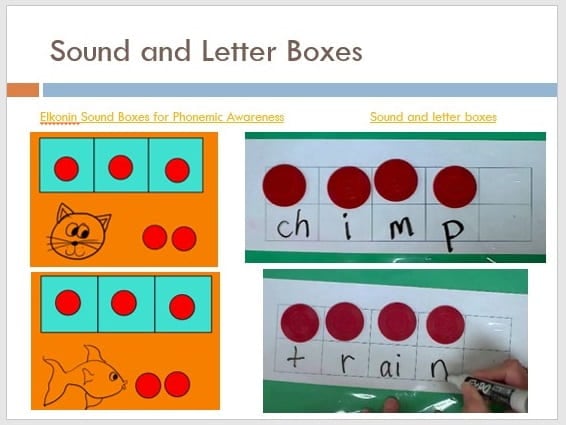by C. Elkins, OK Math and Reading Lady
This is Part 4 of a series about daily reading routines I recommend. Previously we have looked at read alouds, independent reading, and phonological awareness. Today’s focus is Phonemic Awareness. Some videos and freebies via TPT are linked below.

See link #3 below for FREE task cards from TPT
Phonemic Awareness is under the umbrella of phonological awareness. This encompasses pre-reading skills associated with the sounds of language. Phonemic awareness is the part dealing with individual phonemes and how they can be identified, segmented, blended, and manipulated to create recognizable units or words . . . . the auditory portion. Students need a firm foundation with this aspect before they can adequately apply it to phonics and reading (which is where the visual aspects of the letters that make these sounds appears). So here are some basics about phonemic awareness:
- Phonemes are the basic sound units. In the English language there are 44 of them (the consonants, the vowels, digraphs, etc.). Here is a good, short list from Orchestrating Success in Reading by Dawn Reithaug (2002).: 44 Phonemes However, if you want to go more in depth, then this link should satisfy your curiosity (or make you want to quit teaching spelling) from The Reading Well: 44 Phonemes in Detail
- Onsets/rimes: The onset is the part of the word before the vowel. The rime is the part of the word including and after the vowel. Examples: In the word shop, /sh/ is the onset and /op/ is the rime. In the word bed, /b/ is the onset and /ed/ is the rime.
- Identifying: When presented with a word orally, can a student identify the beginning sound or ending sound? Example: What is the beginning sound in the word moon? /m/. What is the last sound in the word jump? /p/. The brackets are used to represent the sound – the child is not asked to name the letter.
- Segmenting: When presented with these words, can a student take the parts or individual sounds apart orally (segment)? Examples: bed = /b/ + /ed/ or /b/ + /e/ + /d/. Students would NOT be asked at this point to identify the letters that make those sounds, just the sounds.
- Blending: When presented with these sounds, can a student put them together orally (blend) to form a word? Examples: /k/ + /at/ = cat; or /sh/ + /o/ + /p/ = shop
- Manipulating: This involves adding, deleting, or substituting sounds. Example: What is /ap/ with /m/ added to the beginning? (map). What is /land/ without the /l/ sound? (and). Change the /b/ in bed to /r/. . . (red).
Daily teaching routine for Phonemic Awareness:
- If using a reading series, check to see if there is a daily practice with words (like the examples above). Just a few minutes with the whole class is a good introduction and chance for you to observe / listen to who is or is not grasping these tasks.
- Use simple pictures (such as fox): Ask students to do some of the following when you feel they are ready:

- Name the picture and tell the onset and rime. /f/ + /ox/
- Orally say all of the separate sounds /f/ + /o/ + /ks/. Use the length of your arm for these cvc words: tap shoulder and say /f/; tap inside elbow and say /o/; tap the wrist and say /ks/. Then run your hand along the whole arm to blend them back together.
- Use an Elkonin sound box to show the distinct sounds. For fox, use a 3-part box. Push a chip into each box as each sound is being made (no letters yet, just chips, beans, cubes, pennies, etc.). Then blend all the sounds together. (I like to put an arrow at the bottom of the boxes and run my finger along it to remind students with a visual that the last step is to blend the sounds together.)
- Change the /f/ to /b/. What word does that sound like? /b/ + /o/ + /ks/ = /box/
- Change the /ks/ to /g/. What word does that sound like? /f/ + /o/ + /g/ = /fog/
- Change the /o/ to /i/. What word does that sound like? /f/ + /i/ + /ks/ = /fix/
- If you remove the /f/ sound, what is left? /oks/ or /ox/
- Be sure to use short and long vowel words, digraphs, etc. because it’s all about hearing the separate parts – not about matching up the letters that make those sounds.
- Follow up these same routines during guided reading and work station time. Here are 2 links from TPT (FREE) with some great sound box practice opportunities:
- From Julie Davis – Big Ideas for Little Hands (FREE): CVC sound box task cards
- From Stephanie Hager: cvc pictures and sound boxes worksheet
Here is a great short video I recommend regarding the Elkonin sound boxes: Sound boxes
When you are ready to progress from sound boxes to letter boxes, these two videos should be very helpful.
These routines will be very important once you feel they are ready to associate the letter(s) that make these sounds (via phonics, spelling, and writing). A phonics routine will be the next topic. So stay tuned!